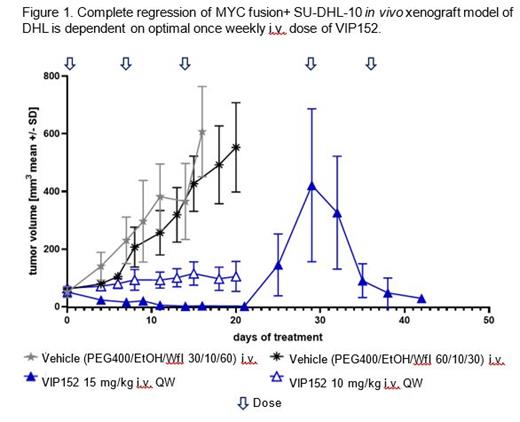Abstract
Background: High-grade B-cell lymphoma (HGBL), previously known as double-hit lymphoma (DHL), is an aggressive type of B-cell non-Hodgkin lymphoma characterized by rearrangements in MYC and BCL2 or BCL6, which drive oncogenic transcription and anti-apoptotic signaling, respectively, and is refractory to standard of care chemotherapy. VIP152 is a well-tolerated and clinically active CDK9 inhibitor leading to complete metabolic remissions in 2/7 HGBL patients treated with once weekly (QW) 30 mg intravenous administration (Lücking et al. J Med Chem 2021; Moreno et al. JCO 2021 (abstr 7538)). Herein, we demonstrate that once weekly inhibition of CDK9 provides an "oncogenic shock"-like (Jain et al. Science 2002) disruption of transcription of MYC and other short half-life mRNA gene transcripts, which provides durable control of oncogenic protein levels without continuous dosing, resulting in apoptosis and antitumor efficacy.
Methods: To understand the mechanism of antitumor efficacy, an evaluation of the pharmacodynamic (PD) extent and duration of CDK9 pathway inhibition was performed in vitro using HGBL cell lines treated with 250 nM VIP152 4 hours (h) pulse and washout time course. PD biomarkers include pSer2 and total RNA Pol II, MYC, MCL1, PCNA and cleaved PARP measured by western blot and RNAseq for transcriptome analysis with confirmation of key short half-life gene transcripts MYC, MCL1 and PCNA by qPCR. The efficacy of VIP152 QW regimen and control following a 2-week regrowth period was evaluated in an SU-DHL-10 in vivo xenograft mouse model. Longitudinal levels of short-lived transcripts compared with the transcriptome were evaluated by RNAseq of whole blood collections predose and postdose on Cycle 1 Day1, Day 8 and Day 15 from 7 HGBL patients treated with 30mg VIP152 QW. Pharmacokinetic /pharmacodynamic (PK/PD) modeling was performed to characterize concentration-effect relationships in 7 HGBL patients for VIP152 on MYC, MCL1 and PCNA mRNA.
Results: In vitro treatment with VIP152 shows ≤12h inhibition of p-Ser2 RNAPol II, the direct substrate of CDK9. Stalling of transcriptional activity by RNAPol II was confirmed with a 6-hour depletion of MYC, MCL1 and PCNA mRNA, as measured by qPCR. Transcriptome analysis demonstrates transient control of gene expression by VIP152 is selective for a subset of genes with a short mRNA half-life. Furthermore, ≤16h of depletion of MYC, MCL1 and PCNA protein confirms that a short pulse of VIP152 treatment is sufficient for durable clearance of oncogenic drivers when mRNA levels are transiently downregulated. VIP152-mediated oncogenic shock is characterized by protein depletion rendering cells susceptible to apoptosis with cPARP peaking at 4h after washout.
To assess the relevance of MYC depletion, VIP152 was evaluated in a MYC fusion+ DLBCL in vivo model (SU-DHL-10). Dose dependent regressions are achieved following 3 doses of VIP152 with 10- and 15-mg/kg QW regimens providing 81% and 98% tumor growth inhibition, respectively, compared with vehicle control. After 2 weeks regrowth of the 15 mg/kg group, retreatment with 2 doses of VIP152 provides 82% tumor volume reduction demonstrating the QW schedule is sufficient to suppress outgrowth (Figure 1).
In HGBL patients (n=7), biomarker modulation is transient with the average maximum postdose depletion of MYC, MCL1 and PCNA mRNA being 94% at 1.4h, 70% at 2.3h and 86% at 4.0h relative to baseline, respectively. Transcriptome analysis confirms that the mechanism of action elucidated from preclinical models translates to patients wherein short half-life transcripts of key oncogenic drivers such as MYC, MCL1 and PCNA are selectively controlled after each of the first 3 QW 30 mg doses of VIP152. Unbound VIP152 IC 50 for MYC, MCL1 and PCNA is 25.4, 30.7, and 20.5 nM, respectively. These are comparable to in vitro DLBCL cell line VIP152 unbound IC 50 of 47 nM.
Conclusions: CDK9 inhibition with VIP152 selectively depletes short half-life transcripts including MYC, a known driver of HGBL. Clearance of MYC, MCL1 and PCNA protein demonstrates VIP152 control of multiple parallel oncogenic pathways in the clinic and in HGBL preclinical models. Dose-dependent regression and tumor-outgrowth control demonstrates that VIP152 QW treatment can drive antitumor efficacy. VIP152 is currently being evaluated in HGBL patients and other indications in the clinic (ClinicalTrials.gov Identifiers: NCT02635672 and NCT04978779).
Frigault: Vincerx Pharma Inc: Current Employment; AstraZeneca: Divested equity in a private or publicly-traded company in the past 24 months, Ended employment in the past 24 months, Patents & Royalties. Wong: Vincerx Pharma Inc: Consultancy; Genentech: Consultancy, Research Funding; Integrative Drug Discovery, ULC: Consultancy. Garban: ImmunityBio, Inc.: Ended employment in the past 24 months, Patents & Royalties; Vincerx Pharma Inc: Current Employment, Current equity holder in publicly-traded company. Greer: Vincerx Pharma Inc: Current Employment; Gilead: Current equity holder in publicly-traded company, Ended employment in the past 24 months. Hwang: Vincerx Pharma Inc: Current Employment, Current equity holder in publicly-traded company. Izumi: Acerta Pharma Inc: Current holder of individual stocks in a privately-held company, Current holder of stock options in a privately-held company, Ended employment in the past 24 months, Patents & Royalties; Vincerx Pharma Inc: Current Employment, Current equity holder in publicly-traded company, Membership on an entity's Board of Directors or advisory committees. Johnson: Janssen: Divested equity in a private or publicly-traded company in the past 24 months, Ended employment in the past 24 months; Vincerx: Current Employment. Stelte-Ludwig: Bayer: Ended employment in the past 24 months, Patents & Royalties; Vincerx Pharma Inc: Current Employment. Hamdy: Acerta Pharma Inc: Current holder of individual stocks in a privately-held company, Current holder of stock options in a privately-held company, Ended employment in the past 24 months, Patents & Royalties; Vincerx Pharma Inc: Current Employment, Current equity holder in publicly-traded company, Membership on an entity's Board of Directors or advisory committees.


This feature is available to Subscribers Only
Sign In or Create an Account Close Modal